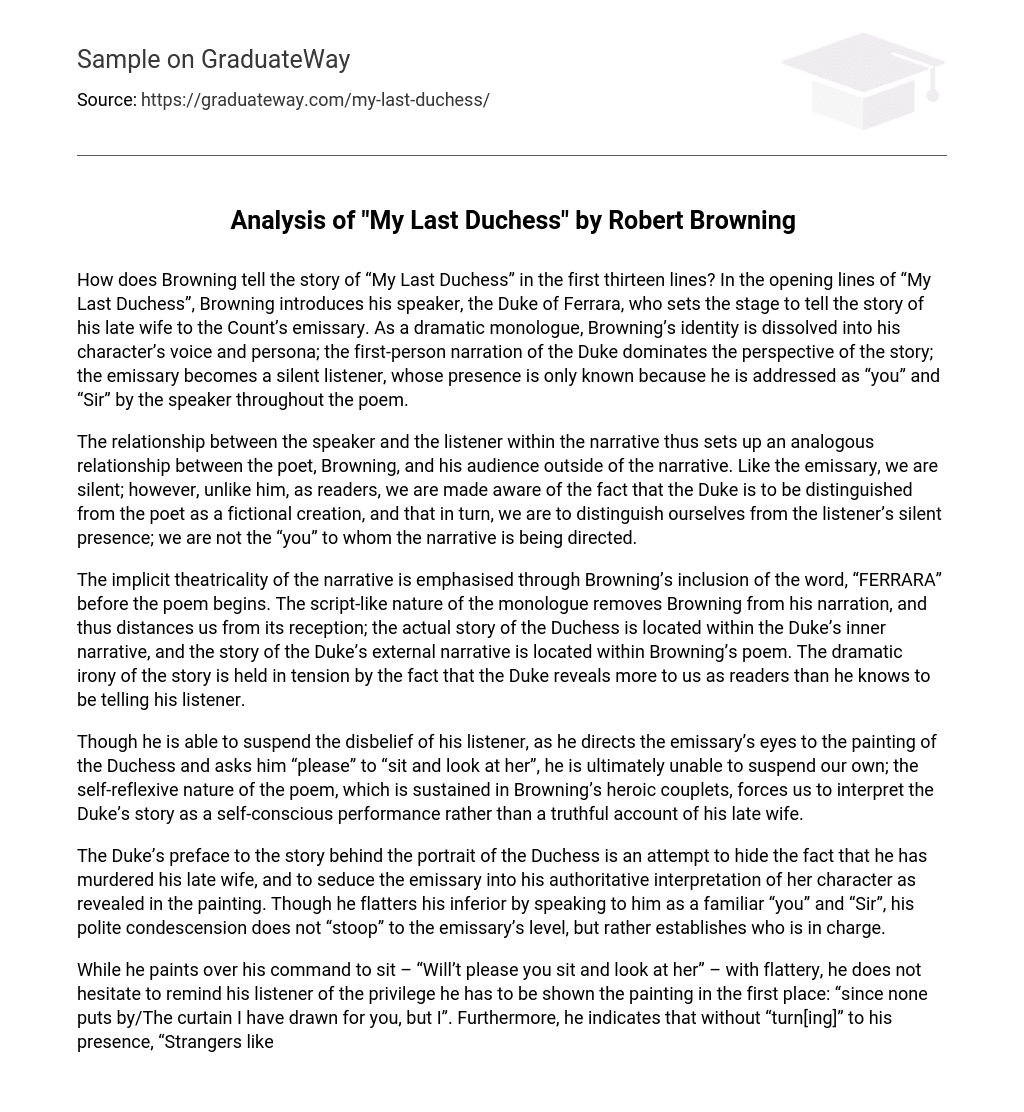The opening lines of “My Last Duchess” by Browning establish the Duke of Ferrara as the speaker who will recount the tale of his deceased wife to the Count’s emissary. This form of dramatic monologue allows for a merging of Browning’s identity with that of the character, enabling a dominant perspective from the first-person narration of the Duke. Throughout the poem, the presence of the emissary is acknowledged solely through references such as “you” and “Sir” made by the speaker.
Within the narrative, the speaker’s relationship with the listener mirrors Browning’s relationship with his audience outside of the narrative. While both we and the emissary remain silent, as readers, we know that the Duke is a fictional character created by the poet. Additionally, it is important for us to distinguish ourselves from the silent presence of the listener as we are not the intended audience of this narrative.
The narrative’s theatricality is emphasized by Browning’s incorporation of the word “FERRARA” at the start of the poem. By presenting the monologue in a script-like manner, Browning separates himself from the narration, creating a distance between us, as readers, and the story being told. The story of the Duchess is nested within the Duke’s thoughts, while the Duke’s own narrative is contained within Browning’s poem. The dramatic irony of the story is created by the fact that the Duke inadvertently reveals more to us as readers than he intends to disclose to his listener.
The Duke’s ability to make his listener believe in the painting of the Duchess is not enough to fool us. The self-awareness of the poem, maintained through Browning’s use of heroic couplets, compels us to see the Duke’s story as a deliberate act rather than an honest retelling of his deceased wife.
The Duke’s preface to the story of the Duchess’s portrait aims to conceal his crime of killing his wife and manipulate the emissary into believing his interpretation of her character as depicted in the painting. Despite using a familiar address of “you” and “Sir” to flatter the subordinate, the Duke’s courteous condescension asserts his authority rather than lowering himself to the emissary’s level.
The speaker uses flattery to cover up his command for the listener to sit and look at the painting. He also reminds the listener that he is privileged to see the painting because no one else is allowed to see it except him. Additionally, he suggests that without acknowledging his presence, strangers will never truly understand the intense emotion conveyed through the painting’s gaze.
Although it is never mentioned explicitly, the story is told without the listener’s request. It can be inferred that the listener has asked for it (“not the first/Are you to turn and ask thus”), but the narration excludes their voice, and the reader assumes that the story will be told regardless of the emissary’s preferences. While the silent listener becomes intrigued by the Duke’s ownership of the poem, Browning’s poetic portrayal of the character’s speech allows the reader to perceive the constraints of the first-person narrative and the lack of confidence underlying the Duke’s insistence on control.
The poem’s title emphasizes the word “my” in “my last Duchess”, indicating that she is no longer alive and implying that he may have a new wife in the future. The complex sentence structure and interruptions within the verses make it challenging to follow. The speaker switches between various subjects such as the painting, Fra Pandolf, the emissary, strangers, and himself.
The sentences in the text have inconsistent lengths, except for the first verse. This inconsistency suggests incoherence in the Duke’s narrative. Browning’s use of verse not only establishes the Duke’s conversational tone, but also reveals his attempt to hide the truth. The truth about the Duchess being dead is as unclear and unstressed as the fact that she appears alive in the painting. However, what stands is not a human being but an objectified piece, an “it,” with only an earnest glance. Additionally, the Duke is oblivious to the double meanings of his “design,” while we know that he actively works to sustain his authority, much like Fra Pandolf. By referring to her as a “piece,” a term containing sexual connotations, he believes he has triumphed over her. However, her objectification as a painting was his only way to possess her.
It is evident that the significance of the Duke’s understanding of Fra Pandolf’s artistic creation is less important compared to our understanding of Browning’s poetry. Despite Browning being less present in the poem than the messenger, he has closed off his portrayal of the Duke; we are urged to analyze the “pictured countenance” while also considering the artist behind it. Unlike the Duke, our task is not to misinterpret, but to reexamine the truth depicted in the painting and breathe life into the Duke’s theatrical display.





